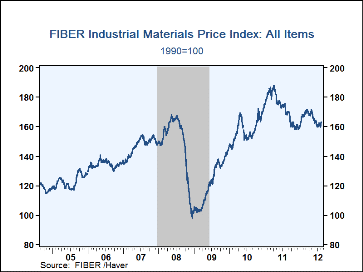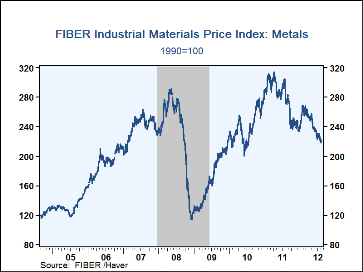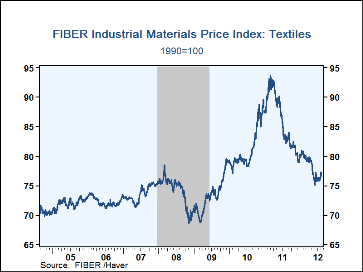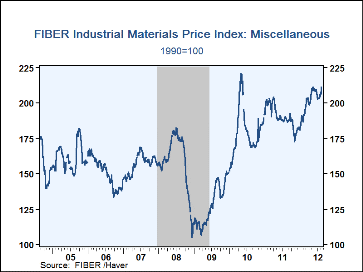 Global| Aug 13 2012
Global| Aug 13 2012FIBER: Industrial Commodity Prices Are Mixed
by:Tom Moeller
|in:Economy in Brief
Summary
Weakening industrial economies have been accompanied by mixed pricing patterns in commodities. At 162.5, the latest price index from the Foundation for International Business and Economic Research (FIBER) is 5.2% lower than its April [...]
Weakening industrial economies have been accompanied by mixed pricing patterns in commodities. At 162.5, the latest price index from the Foundation for International Business and Economic Research (FIBER) is 5.2% lower than its April high and down 3.7% from one year ago. During the last ten years there has been a 44% correlation between the three-month change in prices and the change in factory sector industrial production.
Prices
in the metals group, prices have fallen roughly 3.5% during just
the last two weeks (-18.7% y/y). Lower steel scrap prices have led the
weakness with an 11.5% drop, down one-quarter y/y. Copper scrap prices
(-14.9% y/y) similarly have shown notable weakness in tandem with news of
weakening economies in Europe. Likewise, aluminum prices have moved
moderately lower in the last few weeks but are 21.2% below last year.
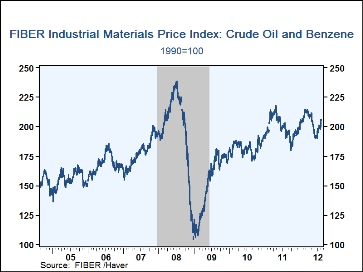
Conversely, geopolitical risks in the Middle East drove crude oil prices to $93.36 per barrel (8.9% y/y) on Friday from a late-June low of $77.79. In addition, textile prices strengthened during the last several weeks. As of Friday, cotton prices recouped two months of decline but still were roughly one quarter below the year ago level. Finally, prices in the miscellaneous group strengthened led by a surge in plywood prices (39.9% y/y). Also, framing lumber prices have risen 21.3% y/y. Conversely, natural rubber prices are at their lowest since 2010.
Relating Commodity Prices to Underlying Inflation: The Role of Expectations from the Federal Reserve Bank of Dallas is available here.
Commodity price data can be found in Haver's DAILY, WEEKLY, USECON and CMDTY databases.
| FIBER Industrial Materials Price Index (1990=100) | 08/10/12 | Y/Y % | 2011 | 2010 | 2009 |
|---|---|---|---|---|---|
| All Items | 162.5 | -3.7 | 172.9 | 157.7 | 121.4 |
| Textiles | 77.2 | -5.9 | 86.1 | 81.2 | 73.3 |
| Cotton (cents per pound) | 71.4 | -25.9 | 132.6 | 87.8 | 52.2 |
| Metals | 220.9 | -18.7 | 278.5 | 239.9 | 167.9 |
| Aluminum ($ per metric ton) | 1,865.5 | -21.2 | 2,400 | 2,172 | 1,662 |
| Copper Scrap (cents per pound) | 339.9 | -14.9 | 400.1 | 326.5 | 195.2 |
| Steel Scrap ($ per ton) | 307.7 | -26.7 | 412.4 | 325.7 | 203.4 |
| Crude Oil & Benzene | 206.4 | 5.6 | 199.3 | 182.0 | 150.9 |
| Crude Oil (WTI, $ per Barrel) | 93.4 | 8.9 | 95.1 | 79.5 | 61.4 |
| Miscellaneous | 206.7 | 9.4 | 190.5 | 178.8 | 127.6 |
| Framing Lumber ($ per 1000 board ft.) | 330 | 21.3 | 273 | 282 | 221 |
| Natural Rubber (cents per pound) | 183.2 | -26.0 | 261.8 | 181.8 | 83.0 |
Tom Moeller
AuthorMore in Author Profile »Prior to joining Haver Analytics in 2000, Mr. Moeller worked as the Economist at Chancellor Capital Management from 1985 to 1999. There, he developed comprehensive economic forecasts and interpreted economic data for equity and fixed income portfolio managers. Also at Chancellor, Mr. Moeller worked as an equity analyst and was responsible for researching and rating companies in the economically sensitive automobile and housing industries for investment in Chancellor’s equity portfolio. Prior to joining Chancellor, Mr. Moeller was an Economist at Citibank from 1979 to 1984. He also analyzed pricing behavior in the metals industry for the Council on Wage and Price Stability in Washington, D.C. In 1999, Mr. Moeller received the award for most accurate forecast from the Forecasters' Club of New York. From 1990 to 1992 he was President of the New York Association for Business Economists. Mr. Moeller earned an M.B.A. in Finance from Fordham University, where he graduated in 1987. He holds a Bachelor of Arts in Economics from George Washington University.


